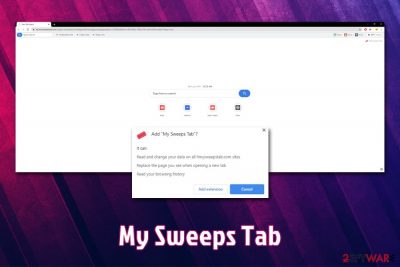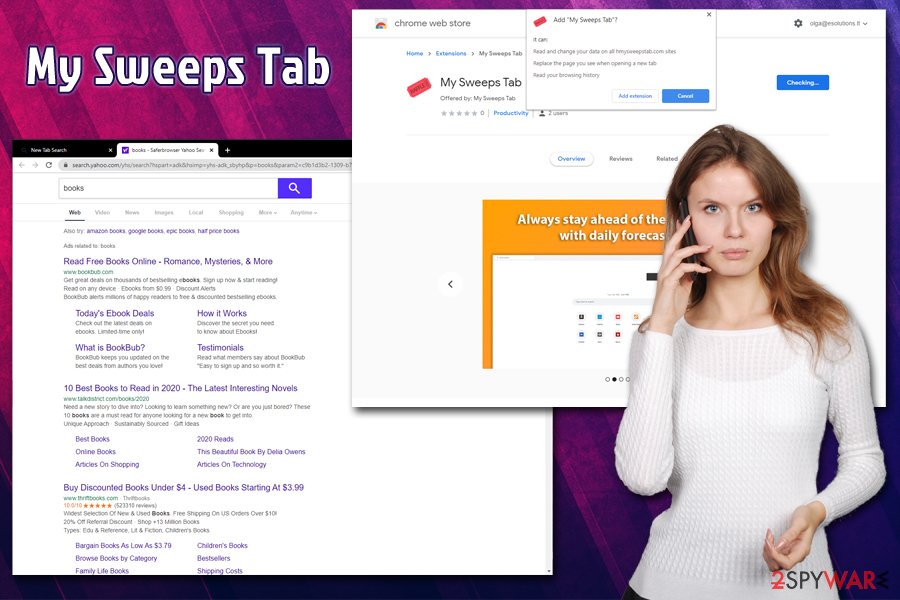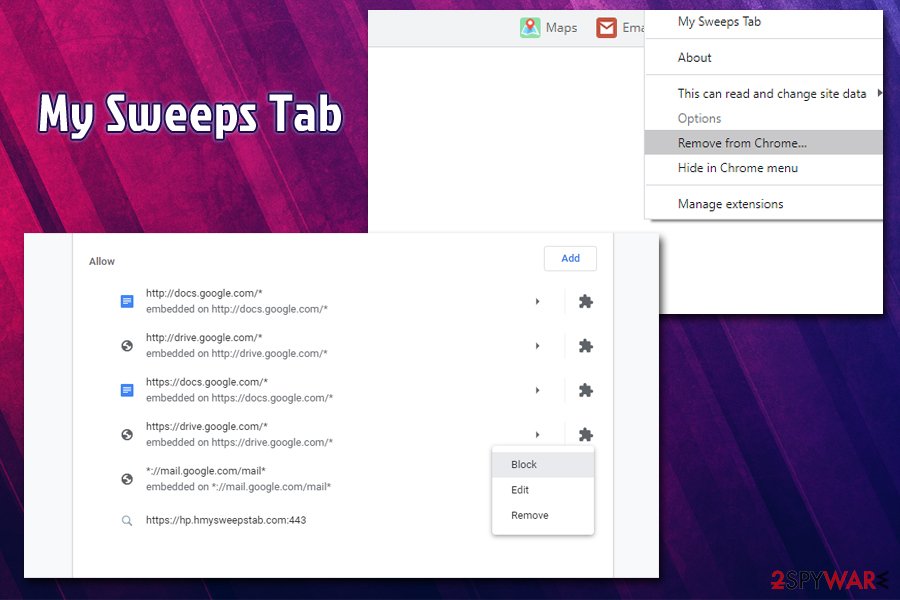My Sweeps Tab (Removal Instructions) - Free Instructions
My Sweeps Tab Removal Guide
What is My Sweeps Tab?
My Sweeps Tab – a browser extension that can read browsing history and track your searches

My Sweeps Tab is a potentially unwanted application[1] that is designed to hijack Google Chrome, Mozilla Firefox, Safari, MS Edge, or another web browser. For that purpose, the extension changes the URL of the homepage and new tab to hp.hmysweepstab.com and appends a customized search engine, which redirects all queries to Yahoo. While browsing the internet via a suchlike modified web browser, users disclose their browsing information to third parties. They are also more likely to visit sponsored websites, as the search results are filled with promotional links and ads.
While some users might install My Sweeps Tab intentionally via such sources like Google Web Store, most find the extension after they download freeware from a third-party website – this is yet another reason why it is considered to be a potentially unwanted program. Additionally, the hijacker will also ask users to allow notifications to be shown – yet another way to promote My Sweeps Tab ads.
| Name | My Sweeps Tab |
| Type | Browser hijacker, potentially unwanted program |
| Infiltration | While the app can be installed via legitimate sources such as Google Web Store, potentially unwanted programs are usually distributed in deceptive ways, such as software bundling or fake update prompts |
| Symptoms |
|
| Risks | While browser hijackers are not considered to be minor browser infections, they can sometimes make users download other potentially unwanted and useless apps, cluttering their machines. Also, when insecure sites are accessed, users might be tricked into subscribing to worthless services, resulting in monetary loss. Finally, the app gathers a variety of data that is later shared with business partners and affiliates |
| Termination | Use the step-by-step instructions provided below or scan your machine with powerful anti-malware software. To stop desktop notifications, you should access browser settings and eliminate the hijacker entry (we explain below how) |
| Optimization | If you machine is struggling after the infection, you can use FortectIntego to fix virus damage automatically |
Just like many similar browser hijackers of this type, My Sweeps Tab boasts its allegedly useful features. Similar apps, such as GameSearch, Safeplex Search, Hide My History, Shipment Trackers, and many others, typically use some type of theme to appeal to a certain audience of people. For this, these hijackers append various links to sites focused on weather, recipes, online games, and other topics.
My Sweeps Tab developers claim that the purpose of this app is to allow users to access popular lottery, bingo, and sweepstake sites quickly. Additionally, the app also appends links to popular sites that provide information to weather or similar seemingly useful features. However, links that allow quick access to websites have been implemented by all modern browsers for a while now – users can customize which sites they want to see as well, rendering this feature relatively useless.
While the developers pretend to care about users' searches, they use the Yahoo engine to feed them ads, display altered search results, and monetize on each click made. In the background, My Sweeps Tab collects a variety of information about those who have the extension installed, as explained in the Privacy Policy:[2]
We may collect information from you based on information collected resulting from your use of our Services and information that you provide to us. The information collected may include both Non-Personal Information and Personal Information.
The gathered data includes:
- Name, email, phone number, if such is provided;
- Hardware model and the operating system type;
- IP address;
- Internet Service Provider;
- Geolocation;
- Browser settings;
- Bookmarks, etc.
Unfortunately, the collected information is also shared with business partners, affiliates, service providers, and some other parties. If you are concerned about your privacy, get rid of My Sweeps Tab hijack as soon as possible.
In most cases, you can remove My Sweeps Tab virus by right-clicking on the extension. However, since potentially unwanted applications typically travel in a bundle, there is a chance that you have other useless apps installed on your system. Thus, you should check your web browsers for additional browser extensions, as well as for the installed apps.

Also, My Sweeps Tab removal might not be complete by just eliminating the extension. In case the push notifications from the hijacker were enabled, you will keep seeing ads and pop-ups directly on your screen even after you uninstall the PUP. Therefore, you should access the settings of your web browser and disallow hp.hmysweepstab.com to show notifications – we provide a full explanation below.
Finally, if you keep seeing ads and your browser is still hijacked, we highly advise you to scan the device with anti-malware software and then reset all the installed web browsers. For best results, we also recommend using PC repair tools like FortectIntego after all suspicious add-ons and apps are termination from the system.
Ways to avoid potentially unwanted applications
Potentially unwanted programs typically travel within software bundles – software packages that include several apps. While the technique itself is not malicious – users can be offered optional apps, of course. Still, the problems begin when third-party websites or software authors attempt to disguise optional components within the installers. As a result, users end up with useless and sometimes even dangerous programs on their systems.
While the technique is deceptive, users can always prevent the unwanted infiltration of apps if they pay enough attention to the installation process of the freeware. In fact, if you only download new applications from official sources, you do not have to deal with deception and installation of programs without permission.
Nonetheless, if you still insist on downloading apps from third parties, we recommend following tips provided by dieviren.de[3] security experts:
- Before installing the app, check its online reviews, blog or forum posts, and find other relevant information online;
- During the installation process, always opt for Advanced/Custom settings instead of Quick/Recommended ones;
- Make sure that the app allows you access to important documents, such as Privacy Policy and ToS;
- Watch out for various tricks: misplaced buttons, pre-ticked boxes, fine print text, misleading offers or deals, etc.;
- Employ reputable anti-malware software that would warn you about the installation of PUPs.
Remove My Sweeps Tab and other potentially unwanted apps from your system
My Sweeps Tab removal from the web browser should not cause you too much trouble, as the hijacker does not require some special permissions during the infiltration process which would stop users from eliminating it successfully. However, many users reported that the pop-up ads from the extension still kept showing up, even after uninstallation of the app. This happens due to enabled notifications, and they can only be stopped via the web browser settings.
To remove My Sweeps Tab ads and pop-ups, perform the following steps on your web browser:
Google Chrome
- Click on Menu and select Settings
- Under Privacy and Security, pick Site Settings
- Select Notifications
- Under Allow, locate hp.hmysweepstab.com entry
- Click on More actions (three vertical dots) and select Block

Mozilla Firefox
- Open Firefox and go to Menu > Options
- Select Privacy & Security section on the left
- Scroll down to Permissions section
- Click on Settings next to Notifications
- Select hp.hmysweepstab.com and pick Block from the drop-down menu
Safari
- Go to Safari > Preferences…
- Under Websites tab, pick Notifications
- Pick hp.hmysweepstab.com and then choose Deny
Finally, if nothing above worked, perform a full system scan with anti-malware software and reset all the installed web browsers as explained below.
You may remove virus damage with a help of FortectIntego. SpyHunter 5Combo Cleaner and Malwarebytes are recommended to detect potentially unwanted programs and viruses with all their files and registry entries that are related to them.
Getting rid of My Sweeps Tab. Follow these steps
Uninstall from Windows
Instructions for Windows 10/8 machines:
- Enter Control Panel into Windows search box and hit Enter or click on the search result.
- Under Programs, select Uninstall a program.

- From the list, find the entry of the suspicious program.
- Right-click on the application and select Uninstall.
- If User Account Control shows up, click Yes.
- Wait till uninstallation process is complete and click OK.

If you are Windows 7/XP user, proceed with the following instructions:
- Click on Windows Start > Control Panel located on the right pane (if you are Windows XP user, click on Add/Remove Programs).
- In Control Panel, select Programs > Uninstall a program.

- Pick the unwanted application by clicking on it once.
- At the top, click Uninstall/Change.
- In the confirmation prompt, pick Yes.
- Click OK once the removal process is finished.
Delete from macOS
Remove items from Applications folder:
- From the menu bar, select Go > Applications.
- In the Applications folder, look for all related entries.
- Click on the app and drag it to Trash (or right-click and pick Move to Trash)

To fully remove an unwanted app, you need to access Application Support, LaunchAgents, and LaunchDaemons folders and delete relevant files:
- Select Go > Go to Folder.
- Enter /Library/Application Support and click Go or press Enter.
- In the Application Support folder, look for any dubious entries and then delete them.
- Now enter /Library/LaunchAgents and /Library/LaunchDaemons folders the same way and terminate all the related .plist files.

Remove from Microsoft Edge
Delete unwanted extensions from MS Edge:
- Select Menu (three horizontal dots at the top-right of the browser window) and pick Extensions.
- From the list, pick the extension and click on the Gear icon.
- Click on Uninstall at the bottom.

Clear cookies and other browser data:
- Click on the Menu (three horizontal dots at the top-right of the browser window) and select Privacy & security.
- Under Clear browsing data, pick Choose what to clear.
- Select everything (apart from passwords, although you might want to include Media licenses as well, if applicable) and click on Clear.

Restore new tab and homepage settings:
- Click the menu icon and choose Settings.
- Then find On startup section.
- Click Disable if you found any suspicious domain.
Reset MS Edge if the above steps did not work:
- Press on Ctrl + Shift + Esc to open Task Manager.
- Click on More details arrow at the bottom of the window.
- Select Details tab.
- Now scroll down and locate every entry with Microsoft Edge name in it. Right-click on each of them and select End Task to stop MS Edge from running.

If this solution failed to help you, you need to use an advanced Edge reset method. Note that you need to backup your data before proceeding.
- Find the following folder on your computer: C:\\Users\\%username%\\AppData\\Local\\Packages\\Microsoft.MicrosoftEdge_8wekyb3d8bbwe.
- Press Ctrl + A on your keyboard to select all folders.
- Right-click on them and pick Delete

- Now right-click on the Start button and pick Windows PowerShell (Admin).
- When the new window opens, copy and paste the following command, and then press Enter:
Get-AppXPackage -AllUsers -Name Microsoft.MicrosoftEdge | Foreach {Add-AppxPackage -DisableDevelopmentMode -Register “$($_.InstallLocation)\\AppXManifest.xml” -Verbose

Instructions for Chromium-based Edge
Delete extensions from MS Edge (Chromium):
- Open Edge and click select Settings > Extensions.
- Delete unwanted extensions by clicking Remove.

Clear cache and site data:
- Click on Menu and go to Settings.
- Select Privacy, search and services.
- Under Clear browsing data, pick Choose what to clear.
- Under Time range, pick All time.
- Select Clear now.

Reset Chromium-based MS Edge:
- Click on Menu and select Settings.
- On the left side, pick Reset settings.
- Select Restore settings to their default values.
- Confirm with Reset.

Remove from Mozilla Firefox (FF)
Remove dangerous extensions:
- Open Mozilla Firefox browser and click on the Menu (three horizontal lines at the top-right of the window).
- Select Add-ons.
- In here, select unwanted plugin and click Remove.

Reset the homepage:
- Click three horizontal lines at the top right corner to open the menu.
- Choose Options.
- Under Home options, enter your preferred site that will open every time you newly open the Mozilla Firefox.
Clear cookies and site data:
- Click Menu and pick Settings.
- Go to Privacy & Security section.
- Scroll down to locate Cookies and Site Data.
- Click on Clear Data…
- Select Cookies and Site Data, as well as Cached Web Content and press Clear.

Reset Mozilla Firefox
If clearing the browser as explained above did not help, reset Mozilla Firefox:
- Open Mozilla Firefox browser and click the Menu.
- Go to Help and then choose Troubleshooting Information.

- Under Give Firefox a tune up section, click on Refresh Firefox…
- Once the pop-up shows up, confirm the action by pressing on Refresh Firefox.

Remove from Google Chrome
Delete malicious extensions from Google Chrome:
- Open Google Chrome, click on the Menu (three vertical dots at the top-right corner) and select More tools > Extensions.
- In the newly opened window, you will see all the installed extensions. Uninstall all the suspicious plugins that might be related to the unwanted program by clicking Remove.

Clear cache and web data from Chrome:
- Click on Menu and pick Settings.
- Under Privacy and security, select Clear browsing data.
- Select Browsing history, Cookies and other site data, as well as Cached images and files.
- Click Clear data.

Change your homepage:
- Click menu and choose Settings.
- Look for a suspicious site in the On startup section.
- Click on Open a specific or set of pages and click on three dots to find the Remove option.
Reset Google Chrome:
If the previous methods did not help you, reset Google Chrome to eliminate all the unwanted components:
- Click on Menu and select Settings.
- In the Settings, scroll down and click Advanced.
- Scroll down and locate Reset and clean up section.
- Now click Restore settings to their original defaults.
- Confirm with Reset settings.

Delete from Safari
Remove unwanted extensions from Safari:
- Click Safari > Preferences…
- In the new window, pick Extensions.
- Select the unwanted extension and select Uninstall.

Clear cookies and other website data from Safari:
- Click Safari > Clear History…
- From the drop-down menu under Clear, pick all history.
- Confirm with Clear History.

Reset Safari if the above-mentioned steps did not help you:
- Click Safari > Preferences…
- Go to Advanced tab.
- Tick the Show Develop menu in menu bar.
- From the menu bar, click Develop, and then select Empty Caches.

After uninstalling this potentially unwanted program (PUP) and fixing each of your web browsers, we recommend you to scan your PC system with a reputable anti-spyware. This will help you to get rid of My Sweeps Tab registry traces and will also identify related parasites or possible malware infections on your computer. For that you can use our top-rated malware remover: FortectIntego, SpyHunter 5Combo Cleaner or Malwarebytes.
How to prevent from getting browser hijacker
Access your website securely from any location
When you work on the domain, site, blog, or different project that requires constant management, content creation, or coding, you may need to connect to the server and content management service more often. The best solution for creating a tighter network could be a dedicated/fixed IP address.
If you make your IP address static and set to your device, you can connect to the CMS from any location and do not create any additional issues for the server or network manager that needs to monitor connections and activities. VPN software providers like Private Internet Access can help you with such settings and offer the option to control the online reputation and manage projects easily from any part of the world.
Recover files after data-affecting malware attacks
While much of the data can be accidentally deleted due to various reasons, malware is one of the main culprits that can cause loss of pictures, documents, videos, and other important files. More serious malware infections lead to significant data loss when your documents, system files, and images get encrypted. In particular, ransomware is is a type of malware that focuses on such functions, so your files become useless without an ability to access them.
Even though there is little to no possibility to recover after file-locking threats, some applications have features for data recovery in the system. In some cases, Data Recovery Pro can also help to recover at least some portion of your data after data-locking virus infection or general cyber infection.
- ^ Potentially unwanted program. Wikipedia. The free encyclopedia.
- ^ Privacy Practices. My Sweeps Tab. Official website.
- ^ Dieviren. Dieviren. Cybersecurity advice and malware insights.























